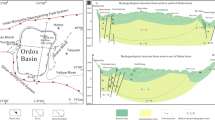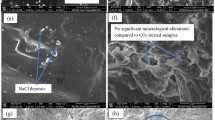Abstract
For a Bunter formation in the German Federal State of North Rhine Westphalia, we use numerical models to consider reactions between the supercritical, aqueous, and solid phases. These reactions may occur in a CO2-water system representing a saline aquifer CO2 storage scenario. Thus, the models are used for determining the extent of fluid–rock reactions during mineral dissolution or precipitation. In particular, we study the effect of temperature by comparing results for our system set at 100 °C and at 58 °C. Results show that the abundance of dissolved ions changes as a result of elevated temperature. For the entire 10,000-year simulation period, the overall geochemical behavior of the Bunter reservoir rock at the Minden site is explained in terms of different mineral transformations, although some of them are not changed significantly. This mainly comprises the alteration of carbonate minerals such as calcite, and aluminium silicates such as oligoclase, chlorite, illite, albite, kaolinite, and Na-smectite. Another chemical behavior derives from the generation and consumption of new secondary minerals such as dawsonite, pyrite, and Ca-smectite. In contrast to a system temperature of 58 °C, the mineralogical transformations of other minerals such as siderite, ankerite, dolomite, and magnesite are not observed at 100 °C. Also, the numerical simulation results show that at elevated temperature, the dominant role played by hydrodynamic mechanism dwarfs the role of other trapping mechanisms including dissolution and mineralization. Results also demonstrate how geological, petrophysical, and geochemical data can be integrated to estimate quantitatively the magnitude of the fluid–rock reactions. These reactions may entail new geotechnical problems, such as rock self-fracturing which ultimately decreases the CO2 sequestration projects security.






Similar content being viewed by others
References
Audigane, P., Gaus, I., Czernichowski-Lauriol, I., Pruess, K., Xu, T. (2007). Two-dimensional reactive transport modeling of CO2 injection in a saline aquifer at the Sleipner site. American Journal of Science, 307, 974–1008.
Bachu, S. (2003). Screening and ranking of sedimentary basins for sequestration of CO2 in geological media in response to climate change. Environmental Geology, 44, 277–289.
Bielinski, A., Kopp, A., Schütt, H., Class, H. (2008). Monitoring of CO2 plumes during storage in geological formations using temperature signals: numerical investigation. International Journal of Greenhouse Gas Control, 2, 319–328.
Borm, G., & Förster, A. (2005). Tiefe salzwasserführende Aquifere - eine Möglichkeit zur geologischen Speicherung von CO2, Energiewirtschaftliche Tagesfragen. Zeitschrift für Energiewirtschaft Recht Technik, und Umwelt, 8, 15–20.
Chadwick, R.A., Arts, R., Bernstone, C., May, F., Thibeau, S., Zweigel, P., (Eds.) (2008). In Best practice for the storage of CO 2 in saline aquifers. No. 14. Keyworth: British Geological Survey Occasional Publication.
Clauser, C. (2003). In Numerical simulations of reactive flow in hot aquifers: SHEMAT and processing SHEMAT. Berlin: Springer.
Ebigbo, A., Class, H., Helmig, R. (2007). CO2 leakage through an abandoned well: problem-oriented benchmarks. Computational Geosciences, 11, 103–115.
Essington, M.E. (2005). Soil and water chemistry: an integrative approach. Taylor and Francis CRC Press. http://books.google.com/books/about/Soil_and_Water_Chemistry.html?id=zy0KmQEACAAJ.
Gaus, I., Audigane, P., Andre, L., Lions, J., Jacquemet, N., Durst, P., Czernichowski-Lauriol, I., Azaroual, M. (2008). Geochemical and solute transport modelling for CO2 storage, what to expect from it? International Journal of Greenhouse Gas Control, 2, 605–625.
Gherardi, F., Xu, T., Pruess, K. (2007). Numerical modeling of self-limiting and self-enhancing cap rock alteration induced by CO2 storage in a depleted gas reservoir. Chemical Geology, 244, 103–129.
Helmig, R., Class, H., Huber, R., Sheta, H., Ewing, J., Hinkelmann, R., Jakobs, H., Bastian, P. (1998). Architecture of the modular program system MUFTE-UG for simulating multi-phase flow and transport processes in hetrogeneous porous media. Mathematical Geology, 2, 123–131.
Hosa, A., Esentia, M., Stewart, J., Haszeldine, S. (2010). In Benchmarking worldwide CO 2 saline aquifer injections. Edinburgh: Scottish Centre for Carbon Capture and Storage.
Johnson, J.W., Nitao, J.J., Knauss, K.G. (2004). Reactive transport modeling of CO2 storage in saline aquifers to elucidate fundamental processes, trapping mechanisms, and sequestration partitioning In S. J. Baines, & R. H. Worden (Eds.), , Geologic storage of carbon dioxide, 233, (pp. 107–128). London: Geological Society Special Publications.
Kaszuba, J., Janecky, D., Snow, M. (2003). Carbon dioxide reaction processes in a model brine aquifer at 200 °C and 200 bars: implication for geologic sequestration of carbon. Applied Geochemistry, 18, 1065–1080.
Kopp, A., Bielinski, A., Ebigbo, A., Class, H., Helmig, R. (2006). Numerical investigation of temperature effects during injection of carbon dioxide into brine. In Proceedings GHGT-8 Conference, Trondheim, Norway, CD-ROM.
Kopp, A. (2009). Evaluation of CO2 injection processes in geological formations for site screening. Ph.D. thesis, Institut fr Wasserbau Lehrstuhl fr Hydromechanik und Hydrosystemmodellierung. Universitt Stuttgart, Stuttgart.
Kühn, M. (2006). Mineralische Bindung von CO2 bei der Speicherung im Untergrund in geothermischen Reservoiren (Mineral trapping of CO2 in underground storage in geothermal reservoirs). Kohlendioxid und Klimaschutz, 76, 425–734.
Lagneau, V. (2003). R2D2-reactive transport and waterflow on an odd dimension 2 grid. Tech. Rep. No. LMH/RD/03/05, Ecole des Mines de Paris, Paris, France.
Lagneau, V., & Pipart, A. (2005). Reactive transport modelling of CO2 sequestration in deep saline aquifers. Oil & Gas Science and Technology - Rev. IFP, 60, 231–247.
Lasaga, A. (1995). Fundamental approaches in describing mineral dissolution and precipitiation rates. In A. White & S. Brantley, (Eds.), Chemical weathering rates of silicate minerals, Reviews in Mineralogy (vol. 31, pp. 23-86). Chelsea: Mineralogical Society of America.
McPherson, B.J.O.L. (Lichtner, P. C.) CO2 sequestration in deep aquifers. In Proceeding of the 1st national conference on carbon sequestration. Washington DC, USA.
Morad, S., Bergan, M., Knarud, R., Nystuen, P. (1990). Albitization of detrital plagioclase in triassic reservoir sandstones from the snorre field, norwegian north sea. Journal of sedimentary petrology, 60, 411–425.
Nadeau, P.H. (1998). An experimental study of the effects of diagenetic clay minerals on reservoir sands. Clays and Clay Minerals, 46, 18–26.
Naderi Beni, A. (2011). Multi-phase, multi-species reactive transport modeling as a tool for system analysis in geological carbon dioxide storage. PhD thesis. Aachen: E.ON Energy Research Center, RWTH Aachen University.
Naderi Beni, A., Clauser, C., Erlström, M. (2011). System analysis of underground CO2 storage by numerical modeling for a case study in Malmö. American Journal of Science, 311, 335–368.
Naderi Beni, A., Kühn, M., Meyer, R., Clauser, C. (2012). Numerical modeling of a potential geological CO2 sequestration site at Minden (Germany). Environmental Modeling and Assessment, 17, 337–351. doi:10.1007/s10666-011-9295-x.
Nitao, J.J. (1995). Reference manual for the NUFT flow and transport code, 1st edn. Lawrence Livermore National Laboratory, Livermore, California, USA. Report UCRL-ID-113520.
Palandri, J.L. (2004). A general rate equation and database of rate parameters for mineral dissolution and precipitation in aqueous fluids (p. 64). U.S. Geological Survey Open File Report 2004–1068.
Pruess, K. (1991). TOUGH2: a general numerical for multiphase fluid and heat flow. Tech. Rep. LBL-29400: Berkeley, California, USA: Lawrence Berkeley Laboratory.
Pruess, K. (2004). Thermal effects during CO2 leakage from a geologic storage reservoir. Tech. Rep. LBNL-55913, Lawrence Berkeley National Laboratory, Berkeley, California, USA.
Pruess, K. (2005). Numerical simulations show potential for strong nonisothermal effects during fluid leakage from a geologic disposal reservoir for CO2. Geophysical Monograph Series, 162, 81–89. American Geophysical Union, Washington DC, USA, Ch. Dynamics of Fluids and Transport in Fractured Rock.
Pruess, K. (2008). Leakage of CO2 from geologic storage: role of secondary accumulation at shallow depth. International Journal of Greenhouse Gas Control, 2, 37–46.
Saadatpoor, E., Bryant, S., Sepehrnoori, K. (2009). Effect of capillary heterogeneity on buoyant plumes: a new local trapping mechanism. Energy Procedia, 1, 3299–3306.
Schilling, F., Borm, G., Würdemann, H., Möller, F., Kühn, M. (2009). Status report on the first European on-shore CO2 storage site at Ketzin (Germany). Energy Procedia, 1, 2029–2035.
Spycher, N., & Pruess, K. (2011). A model for thermophysical properties of co2-brine mixtures at elevated temperatures and pressures. Stanford, California: Proceedings of the Thirty-Sixth Workshop on Geothermal Reservoir Engineering Stanford University. 31 January–2 February 2011. SGP-TR-191.
van der Lee, J., De Windt, L., Lagneau, V., Goblet, P. (2002). Presentation and application of the reactive transport code HYTEC. Computational Methods in Water Resources, 1, 599–606.
White, S.P. (1995). Multiphase non-isothermal transport of systems of reacting chemicals. Water Resources Research, 31, 1761–1772.
White, S.P., Weir, G.J., Kissling, W.M. (2001). Numerical simulation of CO2 sequestration in natural CO2 reservoirs on the Colorado plateau. In Proceeding of the 1st national conference on carbon sequestration. Washington DC, USA.
Wilson, M., & Monea, M. (2004). IEA GHG Weyburn CO2 monitoring and storage project summary report 2000–2004. In Proceedings of the 7th International Conference on Greenhouse Gas Control Technologies (vol. 3). Canada: Vancouver, Regina, Canada: Petroleum Technology Research Center, 5–9 September 2004.
Worden, R.H. (2006). Dawsonite cement in the Triassic Lam formation, Shabwa basin, Yemen: a natural analogue for a potential mineral product of subsurface CO2 storage for greenhouse gas reduction. Marine and Petroleum Geology, 23, 61–77.
Xu, T., & Pruess, K. (1998). Coupled modeling of non-isothermal multiphase flow, solute transport and reactive chemistry in porous and fractured media: 1. Model development and validation. Lawrence Berkeley National Laboratory Report LBNL-42050.
Xu, T., & Pruess, K. (2001). Modeling multiphase non-isothermal fluid flow and reactive geochemical transport in variably saturated fractured rocks: 1. Methodology. American Journal of Science, 301, 16–33.
Xu, T., Sonnenthal, E., Spycher, N., Pruess, K. (2004). TOUGHREACT user’s guide: a simulation program for non-isothermal multiphase reactive geochemical transport in variably saturated geologic media. Lawrence Berkeley National Laboratory Report LBNL-55460.
Xu, T., Apps, J.A., Pruess, K. (2004). Numerical simulation of CO2 disposal by mineral trapping in deep saline aquifers. Applied Geochemistry, 19, 917–936.
Acknowledgments
The authors thank the anonymous reviewer for constructive comments.
Author information
Authors and Affiliations
Corresponding author
Additional information
This study was performed at the Institute for Applied Geophysics and Geothermal Energy, E.ON Energy Research Center, RWTH Aachen University.
Rights and permissions
About this article
Cite this article
Beni, A.N., Clauser, C. The Influence of Temperature on Chemical Fluid-Rock Reactions in Geological CO2 Sequestration. Environ Model Assess 19, 315–324 (2014). https://doi.org/10.1007/s10666-014-9398-2
Received:
Accepted:
Published:
Issue Date:
DOI: https://doi.org/10.1007/s10666-014-9398-2




